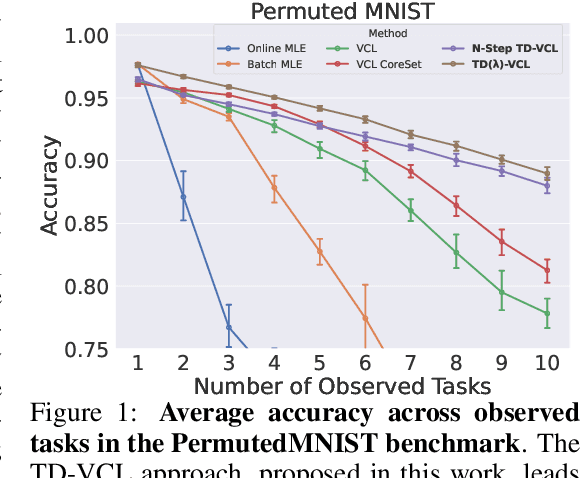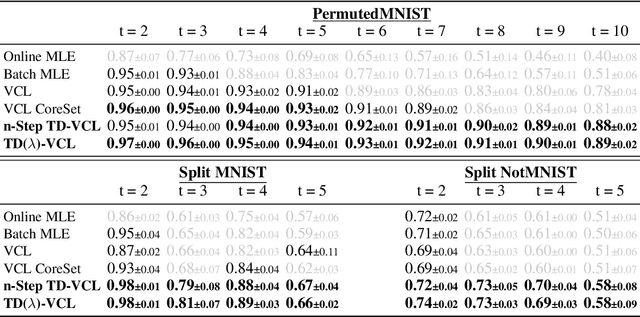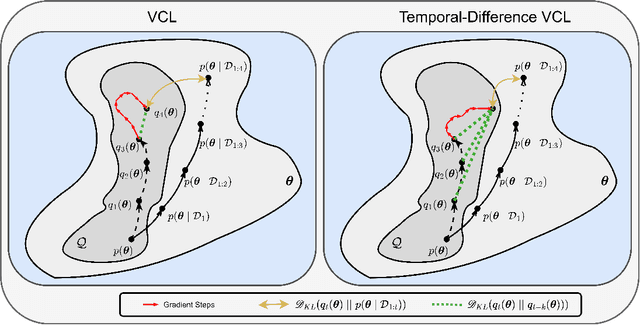Yarin Gal
FindingDory: A Benchmark to Evaluate Memory in Embodied Agents
Jun 18, 2025Abstract:Large vision-language models have recently demonstrated impressive performance in planning and control tasks, driving interest in their application to real-world robotics. However, deploying these models for reasoning in embodied contexts is limited by their ability to incorporate long-term experience collected across multiple days and represented by vast collections of images. Current VLMs typically struggle to process more than a few hundred images concurrently, highlighting the need for more efficient mechanisms to handle long-term memory in embodied settings. To effectively evaluate these models for long-horizon control, a benchmark must specifically target scenarios where memory is crucial for success. Existing long-video QA benchmarks overlook embodied challenges like object manipulation and navigation, which demand low-level skills and fine-grained reasoning over past interactions. Moreover, effective memory integration in embodied agents involves both recalling relevant historical information and executing actions based on that information, making it essential to study these aspects together rather than in isolation. In this work, we introduce a new benchmark for long-range embodied tasks in the Habitat simulator. This benchmark evaluates memory-based capabilities across 60 tasks requiring sustained engagement and contextual awareness in an environment. The tasks can also be procedurally extended to longer and more challenging versions, enabling scalable evaluation of memory and reasoning. We also present baselines that integrate state-of-the-art VLMs with low level navigation policies, assessing their performance on these memory-intensive tasks and highlight areas for improvement.
Protriever: End-to-End Differentiable Protein Homology Search for Fitness Prediction
Jun 10, 2025Abstract:Retrieving homologous protein sequences is essential for a broad range of protein modeling tasks such as fitness prediction, protein design, structure modeling, and protein-protein interactions. Traditional workflows have relied on a two-step process: first retrieving homologs via Multiple Sequence Alignments (MSA), then training models on one or more of these alignments. However, MSA-based retrieval is computationally expensive, struggles with highly divergent sequences or complex insertions & deletions patterns, and operates independently of the downstream modeling objective. We introduce Protriever, an end-to-end differentiable framework that learns to retrieve relevant homologs while simultaneously training for the target task. When applied to protein fitness prediction, Protriever achieves state-of-the-art performance compared to sequence-based models that rely on MSA-based homolog retrieval, while being two orders of magnitude faster through efficient vector search. Protriever is both architecture- and task-agnostic, and can flexibly adapt to different retrieval strategies and protein databases at inference time -- offering a scalable alternative to alignment-centric approaches.
Attacking Multimodal OS Agents with Malicious Image Patches
Mar 13, 2025Abstract:Recent advances in operating system (OS) agents enable vision-language models to interact directly with the graphical user interface of an OS. These multimodal OS agents autonomously perform computer-based tasks in response to a single prompt via application programming interfaces (APIs). Such APIs typically support low-level operations, including mouse clicks, keyboard inputs, and screenshot captures. We introduce a novel attack vector: malicious image patches (MIPs) that have been adversarially perturbed so that, when captured in a screenshot, they cause an OS agent to perform harmful actions by exploiting specific APIs. For instance, MIPs embedded in desktop backgrounds or shared on social media can redirect an agent to a malicious website, enabling further exploitation. These MIPs generalise across different user requests and screen layouts, and remain effective for multiple OS agents. The existence of such attacks highlights critical security vulnerabilities in OS agents, which should be carefully addressed before their widespread adoption.
Do Multilingual LLMs Think In English?
Feb 21, 2025Abstract:Large language models (LLMs) have multilingual capabilities and can solve tasks across various languages. However, we show that current LLMs make key decisions in a representation space closest to English, regardless of their input and output languages. Exploring the internal representations with a logit lens for sentences in French, German, Dutch, and Mandarin, we show that the LLM first emits representations close to English for semantically-loaded words before translating them into the target language. We further show that activation steering in these LLMs is more effective when the steering vectors are computed in English rather than in the language of the inputs and outputs. This suggests that multilingual LLMs perform key reasoning steps in a representation that is heavily shaped by English in a way that is not transparent to system users.
Fundamental Limitations in Defending LLM Finetuning APIs
Feb 20, 2025Abstract:LLM developers have imposed technical interventions to prevent fine-tuning misuse attacks, attacks where adversaries evade safeguards by fine-tuning the model using a public API. Previous work has established several successful attacks against specific fine-tuning API defences. In this work, we show that defences of fine-tuning APIs that seek to detect individual harmful training or inference samples ('pointwise' detection) are fundamentally limited in their ability to prevent fine-tuning attacks. We construct 'pointwise-undetectable' attacks that repurpose entropy in benign model outputs (e.g. semantic or syntactic variations) to covertly transmit dangerous knowledge. Our attacks are composed solely of unsuspicious benign samples that can be collected from the model before fine-tuning, meaning training and inference samples are all individually benign and low-perplexity. We test our attacks against the OpenAI fine-tuning API, finding they succeed in eliciting answers to harmful multiple-choice questions, and that they evade an enhanced monitoring system we design that successfully detects other fine-tuning attacks. We encourage the community to develop defences that tackle the fundamental limitations we uncover in pointwise fine-tuning API defences.
Open Problems in Machine Unlearning for AI Safety
Jan 09, 2025Abstract:As AI systems become more capable, widely deployed, and increasingly autonomous in critical areas such as cybersecurity, biological research, and healthcare, ensuring their safety and alignment with human values is paramount. Machine unlearning -- the ability to selectively forget or suppress specific types of knowledge -- has shown promise for privacy and data removal tasks, which has been the primary focus of existing research. More recently, its potential application to AI safety has gained attention. In this paper, we identify key limitations that prevent unlearning from serving as a comprehensive solution for AI safety, particularly in managing dual-use knowledge in sensitive domains like cybersecurity and chemical, biological, radiological, and nuclear (CBRN) safety. In these contexts, information can be both beneficial and harmful, and models may combine seemingly harmless information for harmful purposes -- unlearning this information could strongly affect beneficial uses. We provide an overview of inherent constraints and open problems, including the broader side effects of unlearning dangerous knowledge, as well as previously unexplored tensions between unlearning and existing safety mechanisms. Finally, we investigate challenges related to evaluation, robustness, and the preservation of safety features during unlearning. By mapping these limitations and open challenges, we aim to guide future research toward realistic applications of unlearning within a broader AI safety framework, acknowledging its limitations and highlighting areas where alternative approaches may be required.
Detecting LLM Hallucination Through Layer-wise Information Deficiency: Analysis of Unanswerable Questions and Ambiguous Prompts
Dec 13, 2024



Abstract:Large language models (LLMs) frequently generate confident yet inaccurate responses, introducing significant risks for deployment in safety-critical domains. We present a novel approach to detecting model hallucination through systematic analysis of information flow across model layers when processing inputs with insufficient or ambiguous context. Our investigation reveals that hallucination manifests as usable information deficiencies in inter-layer transmissions. While existing approaches primarily focus on final-layer output analysis, we demonstrate that tracking cross-layer information dynamics ($\mathcal{L}$I) provides robust indicators of model reliability, accounting for both information gain and loss during computation. $\mathcal{L}$I improves model reliability by immediately integrating with universal LLMs without additional training or architectural modifications.
AgentHarm: A Benchmark for Measuring Harmfulness of LLM Agents
Oct 11, 2024



Abstract:The robustness of LLMs to jailbreak attacks, where users design prompts to circumvent safety measures and misuse model capabilities, has been studied primarily for LLMs acting as simple chatbots. Meanwhile, LLM agents -- which use external tools and can execute multi-stage tasks -- may pose a greater risk if misused, but their robustness remains underexplored. To facilitate research on LLM agent misuse, we propose a new benchmark called AgentHarm. The benchmark includes a diverse set of 110 explicitly malicious agent tasks (440 with augmentations), covering 11 harm categories including fraud, cybercrime, and harassment. In addition to measuring whether models refuse harmful agentic requests, scoring well on AgentHarm requires jailbroken agents to maintain their capabilities following an attack to complete a multi-step task. We evaluate a range of leading LLMs, and find (1) leading LLMs are surprisingly compliant with malicious agent requests without jailbreaking, (2) simple universal jailbreak templates can be adapted to effectively jailbreak agents, and (3) these jailbreaks enable coherent and malicious multi-step agent behavior and retain model capabilities. We publicly release AgentHarm to enable simple and reliable evaluation of attacks and defenses for LLM-based agents. We publicly release the benchmark at https://huggingface.co/ai-safety-institute/AgentHarm.
Temporal-Difference Variational Continual Learning
Oct 10, 2024



Abstract:A crucial capability of Machine Learning models in real-world applications is the ability to continuously learn new tasks. This adaptability allows them to respond to potentially inevitable shifts in the data-generating distribution over time. However, in Continual Learning (CL) settings, models often struggle to balance learning new tasks (plasticity) with retaining previous knowledge (memory stability). Consequently, they are susceptible to Catastrophic Forgetting, which degrades performance and undermines the reliability of deployed systems. Variational Continual Learning methods tackle this challenge by employing a learning objective that recursively updates the posterior distribution and enforces it to stay close to the latest posterior estimate. Nonetheless, we argue that these methods may be ineffective due to compounding approximation errors over successive recursions. To mitigate this, we propose new learning objectives that integrate the regularization effects of multiple previous posterior estimations, preventing individual errors from dominating future posterior updates and compounding over time. We reveal insightful connections between these objectives and Temporal-Difference methods, a popular learning mechanism in Reinforcement Learning and Neuroscience. We evaluate the proposed objectives on challenging versions of popular CL benchmarks, demonstrating that they outperform standard Variational CL methods and non-variational baselines, effectively alleviating Catastrophic Forgetting.
TextCAVs: Debugging vision models using text
Aug 16, 2024Abstract:Concept-based interpretability methods are a popular form of explanation for deep learning models which provide explanations in the form of high-level human interpretable concepts. These methods typically find concept activation vectors (CAVs) using a probe dataset of concept examples. This requires labelled data for these concepts -- an expensive task in the medical domain. We introduce TextCAVs: a novel method which creates CAVs using vision-language models such as CLIP, allowing for explanations to be created solely using text descriptions of the concept, as opposed to image exemplars. This reduced cost in testing concepts allows for many concepts to be tested and for users to interact with the model, testing new ideas as they are thought of, rather than a delay caused by image collection and annotation. In early experimental results, we demonstrate that TextCAVs produces reasonable explanations for a chest x-ray dataset (MIMIC-CXR) and natural images (ImageNet), and that these explanations can be used to debug deep learning-based models.
 Add to Chrome
Add to Chrome Add to Firefox
Add to Firefox Add to Edge
Add to Edge